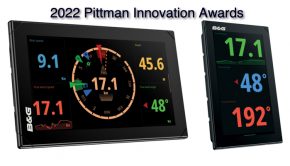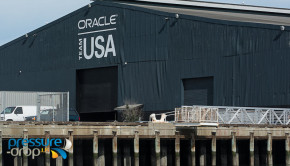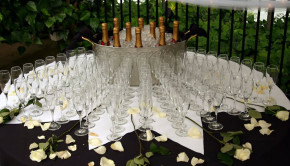Brad Van Liew: Back in the game
Published on January 27th, 2010
 (January 27, 2010) Brad Van Liew will be competing in the VELUX 5 OCEANS 2010-11, the oldest single-handed round the world yacht race. Run every four years since 1982, the race is a series of five high-pressure ocean sprints within a marathon circumnavigation. In the course of the 30,000 mile race, the skippers cross five oceans alone.
(January 27, 2010) Brad Van Liew will be competing in the VELUX 5 OCEANS 2010-11, the oldest single-handed round the world yacht race. Run every four years since 1982, the race is a series of five high-pressure ocean sprints within a marathon circumnavigation. In the course of the 30,000 mile race, the skippers cross five oceans alone.
Van Liew’s new ocean racing campaign targets the popular and exciting Eco 60 Class, and constitutes the first United States entry in the race. The move represents a return to the race he famously won in 2003 as the skipper of the Class II Tommy Hilfiger Freedom America. Here he provides an update for Scuttlebutt:
Brad, you have done this race twice. How did you get started in this type of racing?
In 1986 I was working for the summer aboard Dyer Jones’ boat based in Newport, Rhode Island, enjoying a summer of New England regattas with Dyer, my uncle Fred Van Liew and a great crew of guys when the BOC Challenge (now the Velux 5 Oceans) finished in Newport. I was instantly mesmerized by the sailors who competed in this type of event and the futuristic boats they sailed. Following his class II victory in the race, Mike Plant was willing to take a lunch with me so I could ask him all of my burning questions. By the end of that lunch he had become my hero and mentor. I knew from that moment forward that in some way my life would be intertwined with singlehanded racing.
For your 2002-03 victory you were sponsored by Tommy Hilfiger, and the boat was completely branded. This level of branding seems normal now, but was it normal then?
Not in the U.S. market. The Europeans seemed to be a bit ahead of us in this regard. In fact one of my biggest hurdles in attempting to find sponsorship for the first solo race I wanted to do in 1990 was trying to overcome the doubt and resentment towards commercializing the sport of sailing. By the time I started my second solo race in 2002 the world of professional sailing and full branding had become the norm, but I still think we took it to a new level here in the U.S. with Tommy Hilfiger. I mean even the interior was tricked out in a Tommy branded flare.
You took a break after doing the race twice. Why?
 Brad won the 2003 race as the skipper of the Class II Tommy Hilfiger Freedom America. Photo by Billy BlacK.
Brad won the 2003 race as the skipper of the Class II Tommy Hilfiger Freedom America. Photo by Billy BlacK.
Well, there were a few reasons and frankly I didn’t think I would ever want back in the ring. I had become a father and wanted to be around my family more. My wife (and business partner) Meaghan and I were both burned out. I had spent 70,000 miles in solitude during 1998/99 and 2002/03 and believe it or not, I like being around people. I also felt like I had achieved what I wanted to achieve. When I left the pro racing scene, life seemed to be more about the destination. Now I am more about the voyage again.
What is the attraction of the V5O for you compared to some of the other circumnavigation races?
The Velux 5 Oceans has a fantastic route with great stopover locations, which allows the competitors to develop bonds that add a character to this race unlike any other. Often times your rivals are also your friends, and your safety net in some instances. The dynamic of intense sprints from port to port, means you can push harder than you would in lets say, the Vendee Globe; and the sooner you get to port, the more time you have to prep for the next sprint. Specifically considering the 2010-11 edition of the race, the attraction for me largely is the ECO 60 class being offered. It allows for an American entry to happen at a budget we feel can be sold to sponsors and be competitive. Finding the necessary funds to be truly competitive in a Vendee and the entire IMOCA circuit is unlikely in the U.S. market. I am hopeful some day that will change and the U.S. will really be able to make a run at it.
Sponsorship is a huge component for a successful campaign. Yet these are tough times for a new program to get started. How confident are you that you will reach the starting line?
I am confident enough that Meaghan and I left the security of our full time jobs to dedicate ourselves to the project. We are making good progress and have a team of talent supporting the effort. We are in a better position now, with the success of two previous programs and tangible sponsorship results, than ever before. It is actually a heck of a value when compared to other sponsorship properties. Of course, I would have much preferred to announce the campaign at the same time as our title sponsor. I have always been jealous of folks who lob up to the first interview wearing the logo of their sponsor. It just never seems to work that way for us. In these tough times we will likely have to be creative and offer really good return to sponsors but I think we will be there on October 17th for the big dance.
Do you believe the awareness of this type of racing has changed here in North America?
I am probably too close to it to be objective. I do know sponsors make their money off programs like this when the PR machine can churn out the news and get placement in adventure and lifestyle media outlets. The extreme adventure “story” is where the general public finds this compelling. The Internet, robust handheld devices and social networking are only going to help spread the news of American talent in races like the Velux. I think more U.S. talent in these races certainly helps increase the awareness in North America. In France, these races are covered as any other major top 10 sport. Here in the U.S. it is more of a case by case scenario, where the story is more about the individual. I would like to see this change and see shorthanded racing do what it has done in Europe and propel the sport into countless living rooms of people who have no interest in sailing. If Alaskan king crab fishermen and truckers can do it then sailors can.
Do you see your program being supported by North American based companies, or do you think there is more hope for Euro companies seeking to market themselves in N.A. and using you as there platform?
I think you just laid out both of the likely scenarios and it could really be either. Also in a way it could be both, in that so many companies have become so global. I could see the American portion of a global company activating the sponsorship in the U.S. market while simultaneously trying to leverage their global audience and consumer base. My previous two races have been sponsored by American companies, Balance Bar and Tommy Hilfiger, but that is not to say the projects were not leveraged in a big way outside the U.S. Tommy Hilfiger did an entire fashion show and hospitality event in Rio at the Copacabana while the race was in Brazil. The media results were widespread in the U.S. and internationally.
Do you see yourself now continuing like many of the professional sailors, doing race after race?
I don’t know. I need to see what happens with this race from a personal and professional point of view. Some of this goes back to; can an American team find the support to go big? The sport continues to change from a technology standpoint. This has had an impact on the life of a competitive career in solo ocean racing. Marc Guillemot, who just took honors as champion in the entire IMOCA series is 50, while Vendee Globe winner Michel Desjoyeau is 44. The fact that I may be in my prime at 41 years old is pretty amazing really.
Check out Brad’s website at: www.oceanracing.org









 We’ll keep your information safe.
We’ll keep your information safe.